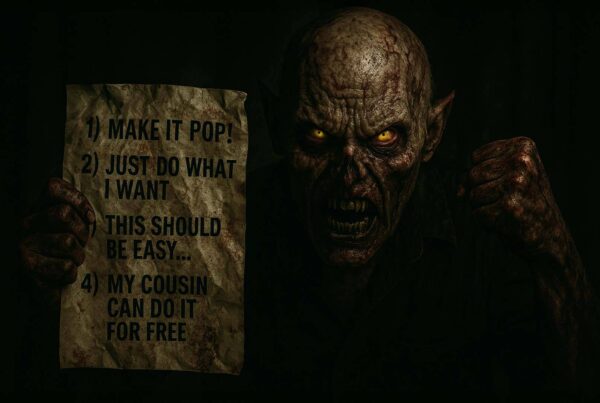The Client Won’t Reply – Email This
The project was going smoothly, and then, all of a sudden, a day goes by with no response. One quiet day turns into two, then five, then two weeks, and no response to your check-ins.
If you work in the creative industry long enough, this will eventually happen to you (if it hasn’t happened already). What can you do to get this client to reengage?

FYI – I made this image of a designer emailing a ghosting client by taking a “mostly lame” stock photo and the new Generative Fill AI function in Photoshop (Beta). TBH – it turned out better than I expected…although still mostly lame. Haha.
Try a Phone Call
This should be the biggest “no duh” of all time, but it still needs to be said. Call the client! Too many creatives try to avoid phone calls. Don’t. Get on the phone. And if that doesn’t work…
Connect With Someone Else
Look through your client correspondence and see if there is someone else at the company you can reach out to. A message like this can usually do the trick…
“I haven’t heard from ______ regarding our project, so I’m reaching out to you to make sure everything is ok at your company. Would you mind sending me a brief email response?”
Still not getting a response…
The Magic Email
There is a “magic email” floating around to help in situations like these. I’ve been asked about it several times, so I’m finally putting some formal thoughts here. The “magic email” is the brainchild of Kai Davis, a coach for marketing consultants. (Full disclosure, I don’t know Kai at the time of this article, but I checked out his site and he looks like a talented dude.)
The “magic email” was created to get absentee clients to respond. And here it is…
“Since I have not heard from you on this, I have to assume your priorities have changed.”
That’s it. Just send that message and nothing else.
According to Kai, he gets at least a 50% response rate, with most being positive. That’s a pretty solid response rate, and I’m certain that message has worked for numerous freelancers and agency owners.
However, that approach feels “off brand” for me. Here are the reasons I personally wouldn’t use it.
(And again, I’m not saying you shouldn’t or it isn’t good. There are a lot of ways to navigate clients and communicate, and the “magic email” is certainly one of them. If it work for you, then keep using it.)
Assumptions
The “magic email” assumes the client is ghosting you due to a shift in priorities or they are bad at communication…that they are being rude not replying to you, so you can be “sort of rude” or at least “direct” back to them.
I prefer an empathetic approach. Instead of assuming they are being rude by not replying to my messages, I begin to hope everything is ok on their side.
- Were they in an accident and find themselves in the hospital?
- Did they lose their job at the company?
- Is everything ok in their family?
- Is their business ok?
There are a myriad of justifiable reasons for not replying to your messages, and it is on brand for me to give them the benefit of the doubt.
To that end, here is an adapted version of a “magic email” that leaves room for empathy in case someone’s life was upended.
The Empathetic Email
Your client is ghosting you. You are trying to reengage. You’ve made a phone call and sent an email to someone else at the company. Still no response. Try sending this email…
Dear <CLIENT>,
I hope everything is okay. I’ve sent you a few emails and not received a response. To be honest, I’m a little concerned and hope you are doing alright. Please let me know.
We are planning to archive the project due to a lack of response. Before we do, please reply with one of the following…
A. Priorities have changed, and I am ready for the final invoice.
B. Let’s restart the project now.
C. Let’s restart in a few weeks.
I look forward to hearing from you!
Thank you,
<NAME>
This email still makes it easy for the client to reply, but it also shows a little empathy by expressing concern for the client. It also retains common courtesies in “greeting” and “closing” the email. I am much more comfortable with this approach.












